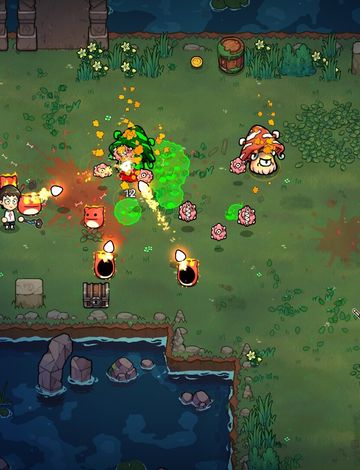I have always advocated for exploratory gameplay and immersive narratives, making open-world RPGs my favorites. However, roguelikes, with their high replay value and randomly generated content, have their charm that can either captivate or frustrate players. “Magicraft” melds these genres by offering a magical aerial fantasy world invaded by ancient gods that the player must save. So how does it fare in delivering this ambitious blend? Let’s dive in.
Core Gameplay
“Magicraft” is rooted in roguelike traditions but adds unique flavors. Procedural generation allows for an ever-changing landscape. Players take on the role of a brave soul who stumbles upon a legendary staff and embarks on an adventure to battle monsters, wield unique spells, and save the world.

Unique Features
One standout feature is the ability to combine spells and relics collected throughout the game. These combinations can lead to fascinating and powerful magical effects, making each playthrough distinct. However, the randomness can sometimes feel unforgiving. Your success heavily depends on the luck of the draw with spells and relics.
Visuals and Atmosphere
The game’s cute, magical painting style is both charming and whimsical. Vibrant and colorful visuals significantly enhance the fantasy atmosphere. The creature design is imaginative, and the environments—from enchanted forests to ancient castles—are visually engaging, maintaining a compelling sense of wonder throughout.

Storyline and Characters
The narrative is simple, almost to the point of being nonsensical. You are the chosen one destined to wield the staff and save the world from invading ancient gods. While the plot isn’t groundbreaking, it serves as a sufficient backdrop to the colorful gameplay. Characters in “Magicraft” are somewhat one-dimensional, lacking the depth that makes narratives in RPGs engaging. However, in a roguelike setting, the primary draw is often the gameplay loop rather than a deep story.
Combat and Replayability
One of the game’s most notable strengths is its combat system. The combination of spells leads to visually spectacular and satisfying combat encounters. The dynamic nature of each playthrough due to procedural generation adds to the game’s replayability. On the flip side, this randomness can work against the game, sometimes making it feel like a grind if you’re not fortunate with drops.

Puzzles and Challenges
The puzzle-solving elements are fun but can feel like mere distractions rather than integral parts of the gameplay. They break up the action but don’t add substantial depth or challenge.

Final Thoughts
Magicraft is a whimsical and engaging experience, especially for those who appreciate the roguelike genre and a bit of magical flair. Its vibrant art style and dynamic spell combination system stand out as its most significant successes. However, the lack of depth in the story and characters, coupled with sometimes frustrating randomness, keeps it from reaching the heights of other top-tier roguelikes.
For fans of roguelikes looking for something with a lighter, more colorful touch, Magicraft is worth a try. However, for those who prefer structured narratives and consistent progression, it might fall short.
Rating: 3 out of 5 stars

Gamer Tip: Focus on experimenting with different spell and relic combinations. This strategy can lead to discovering powerful effects and makes each playthrough unique.
If you enjoy games with high replay value and don’t mind a bit of randomness in your loot and progression, “Magicraft” will likely appeal to you. Its whimsical graphics and spell-casting mechanics provide a refreshing take on the roguelike genre. Dive in if you’re up for a magical, ever-changing adventure!
Want to check it out yourself? Click here to see it on Steam.

